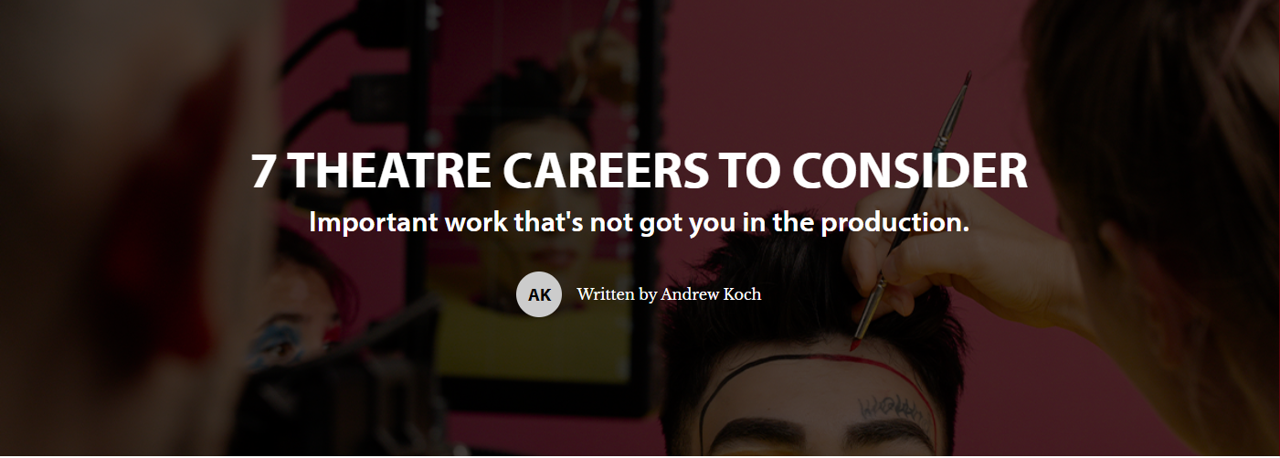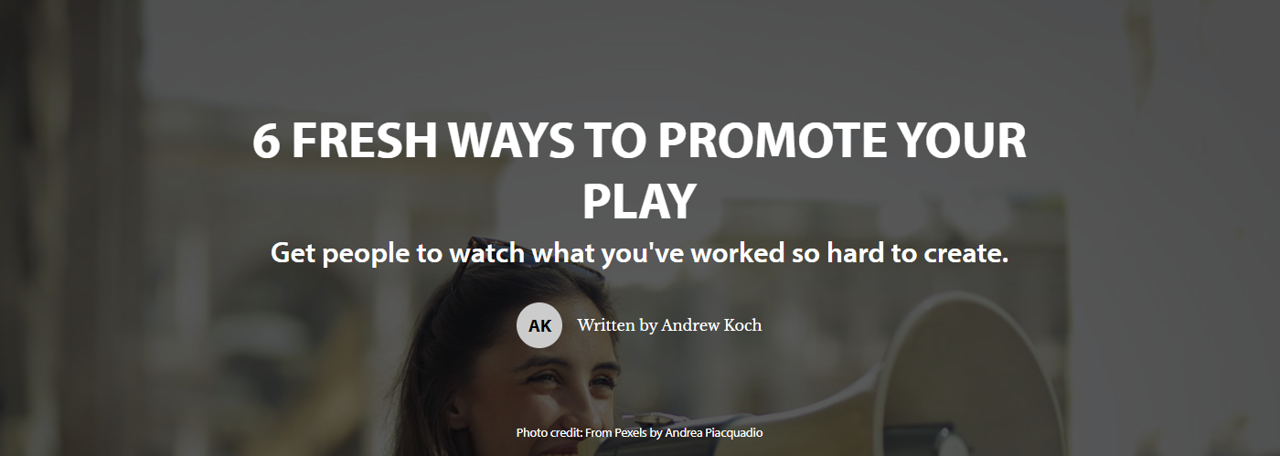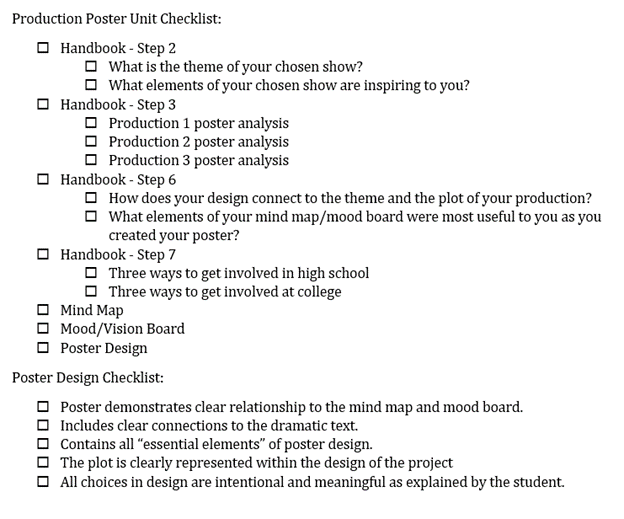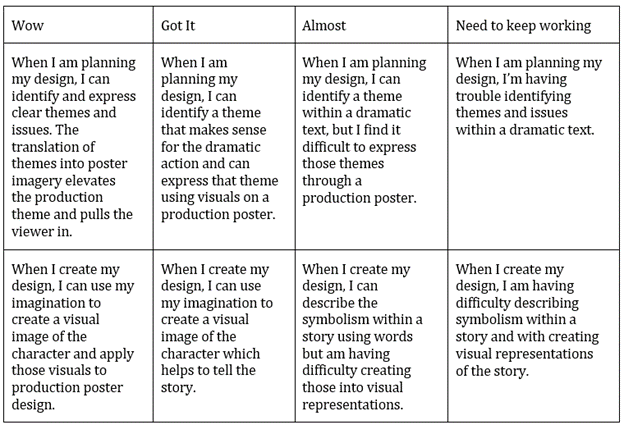
Click to Teach/Click to Learn: Creating a Production Poster
In this unit of instruction, students will design a production poster. Students will learn to create a mind map and mood board and will use those elements along with their knowledge of the chosen production to create a poster. This lesson is best suited for middle grades and should take 5-7 class periods.
Students will be able to:
- Identify the essential events in a story or script that make up the dramatic structure in a drama/theatre work.
- Explain and present solutions to design challenges in a drama/theatre work.
- Choose a variety of technical elements that can be applied to a design in a drama/theatre work.
Step 1: Get Inspired

View this gallery of selected works of Frank “Fraver” Verlizzo – the man behind several of Broadway’s most iconic production posters.
Consider the following as you take a look at these posters:
- What images, colors, or posters stand out the most to you from this collection? Why?
- What things in your life inspire you or make you feel creative?
Step 2: Choose Your Production
In this unit, you will become the poster designer for your own production! Choose a show for which to design your poster. You can choose a show your school is actually producing or can pick a show you like. You’ll want to be familiar enough with the plot and themes that you can design effectively. You’ll answer a few questions along the way – these questions and answers will become your Poster Production Handbook.
In your Poster Production Handbook, answer the following questions:
- What is the theme of your chosen show?
- What elements of your chosen show are inspiring to you?
Step 3: The Elements of a Poster
Choose three of Fraver’s posters (from Step 1) to analyze based on the tech theatre toolkit by Brandon Goodman. For each poster, write down the following in your handbook:
- Name of show
- What draws your eye to the poster?
- Is the text easy to read?
- If you had to guess what the show was about, what context clues can you use to determine the topic?
In preparation for your design, review Mr. Goodman’s essential elements of a poster.
Step 4: Create a Mind Map
Considering the theme of your chosen show, create a mind map to help you start your design. You can create your mind map by hand or digitally.
Step 5: Create a Mood Board
Another way to brainstorm ideas is to use a mood board. You can see additional examples of a vision or mood board in this article. Working with the theme of the show and your mind map, create a mood/vision board that demonstrates colors, textures, images, vibes, etc., that you hope to reflect in your production poster.
You can create a physical mood board using magazine clippings, paper, fabrics, colored pencils/markers, and other materials, or you can create a digital mood board using online resources and design tools.
Step 6: Design Your Poster
Now that you have explored themes, colors, patterns, images, and more as you created your mood board, mind map, and production poster handbook, you are ready to design your poster! Your poster should contain all of the “essential elements” from Step 2 (be sure to use your school or a fictional production company when creating your poster). You can create your poster digitally or you can draw it on paper.
Interested in more design tips? Check out this video.
In your poster production handbook, write a paragraph explaining your design choices. Answer the following questions:
- How does your design connect to the theme and the plot of your production?
- What elements of your mind map/mood board were most useful to you as you created your poster?
Step 7: Consider a Career
Poster design is an area of theatre production that you may not have considered before. There are many other atypical or “alternative” theatre careers out there. Read this article from dramatics.org, and choose one career from the list that interests you. In your handbook, write down your chosen career and list three ways someone could get involved with that kind of work at high school (classes, extracurriculars, etc.) and three classes someone might take at the college level if they wanted to pursue that career.

Diving Deeper: Marketing Plan
Read through this list of suggestions on dramatics.org on how to promote your production. Create a marketing plan that covers a month out from your production and lists all of the promotional things you will do or create in that time to help market your show.

Just For Fun
Create a “trailer” for your production. If you created your poster for a realized production, film some rehearsal and behind-the-scenes footage and create a video advertisement. If your production was chosen for this exercise, get creative! Create your own “rehearsal footage” with friends and family or simply use text and voiceover (and your poster!) to create your production trailer.
Measuring Learning
Classroom Connections
This lesson is best suited for middle grades.
Grade 6
TH:Cr3.1.6.c. Explore a planned technical design during the rehearsal process for a devised or scripted drama/theatre work.
TH:Pr.4.1.6.a. Identify the essential events in a story or script that make up the dramatic structure in a drama/theatre work.
Grade 7
TH:Cr1.1.7.a. Explain and present solutions to design challenges in a drama/theatre work.
TH:Pr5.1.7.b. Choose a variety of technical elements that can be applied to a design in a drama/theatre work.
| Access Date | Quiz Result | Score | Actions |
|---|
Learning Center
- Webinars
- Adjudication Trainings
- Featured Courses
- Full Course List
- Lesson Plan Library
- Click to Teach Interactive Online Lessons
- Resources for New Theatre Teachers
- Technical Theatre Educator's Manual
- Connected Arts Networks
- Diverse Resources for Theatre Education
- Behind the Scenes Technical Theatre Curriculum
- Social & Emotional Learning
- Additional Standards Based Instructional Resources
- Search the Catalog
- Cart (0 items)
Full Site Search
Membership Benefits
Join EdTA for full access to our professional development and standards-based teaching resources, including:
- 300+ lesson plans
- Click to Teach online lessons
- K-12 curriculum
- Webinars
- And more!





